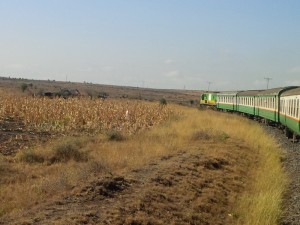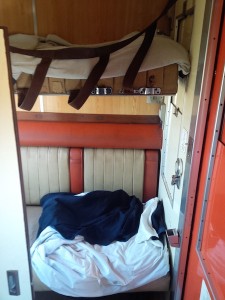What if the salesperson, at a company you want to buy from, tells you not to buy their products and you still go ahead to, because of nostalgia and history?
It’s been eight years since this last review and there are some major differences
- There used to be two trains per days, now there is one train, that makes numerous stops
- The train runs to Mombasa three times a week (M, W, F), and the same to Nairobi on alternate days (T, R, S)
- The meals are done by Pride Inn hotel group
- The train is usually late

Late lunch at Kenya Railways
The train was meant to leave at 7 p.m., and get to Mombasa at 10 a.m. the following day. But we got called at 10 a.m. the day of the trip to be told that the night train was late, and to come in at 10 p.m.
This we did, and there was still no train at the station, just the night managers who said this does happen a lot. There were other passengers waiting, and it was clear that they would take the train no matter what time it came, as it was their only transport from Nairobi to whatever town they were heading on the route. The station master said that when the train came, it would take more than an hour to clean and ‘fill the water’ before the return journey.
We left a phone number with the station master and went back home and kept calling every half hour back to check if the train had come. It did come in at about 3 a.m. and we went back to the station. At about 4 a.m. the train pulled up from the yards, and after showing our receipts, we were issued with boarding cards for the first class cabins. A first-class ticketis Kshs 4,505 ($45) for adults and 2,795 ($28) for children for full board travel which is dinner, breakfast, and beddings in the cabin for each person.
Dinner was served at 5 a.m., and shortly afterward, the train departed Nairobi for what turned out to be an interesting and very long day trip. When we got back to the rooms, the beds had been made up by the train staff and we went to sleep for a few hours, till the bell rang again to announce breakfast was served. This was at about 10 a.m. and it was back to the dining car that seats about 40, in tables of 4.
The train made many stops in places such as Konza, Sultan Hamud, Makindu, and Ulu, and it got to Mtito Andei which is the mid-point of the journey at about 2 P.M. At these small -town stations, passengers in the third class cabins would get on or off the train with their luggage.
That should have been it for meals, but at about 5 p.m. the crew again to summoned first class passengers for an unexpected late lunch meal. After that, it was back to either watching the afternoon views or taking another sleep break in the cabins
The delayed train afforded some unusual daytime views not seen on past trips. Two particular new sights were views of the SGR, the new China-built standard gauge railway which for many kilometers, runs parallel to the old railway. Also after Mtito Andei, and once the train was passing the Tsavo Park, there were also sightings of wildlife including several giraffes and elephant herds in the evening.
The train is able to attain a decent speed of almost 60 kilometers per hour when the railway is straight and there are no slopes to navigate or stops to make.
But cargo is clearly the priority for the Rift Valley Railways consortium who run the railway (it is said that 99% of their revenue is from cargo, with just 1% from the passenger trains) – and on at least three occasions, our passenger train had to stop for 10-30 minutes at a station, to wait for a heavy cargo train to pass on the way to Nairobi. The trains had wagons go goods or fuel for Uganda, or wagons for the Magadi soda ash factory.
The train eventually got to Mombasa at 1 a.m., having left Nairobi at 5 a.m. the day before. Mombasa station seems to have lost or leased some space in its front yard to a private developer and there’s now a lorry sales lot where cars used to park.
Some other advice;
- Carry extra snack foods, and soft or hard drinks of choice.
- Carry wipes, toilet paper, bug spray.
- Have reading material and fully charged devices



Growing up in rural central Kenya I heard enthralling stories about traveling to Mombasa by train from people whose fathers/husbands worked there, and dreamed of taking a train there some day. But we are in 2015, and this sounds like a lone matatu service from a remote Nyandarua village in the 90s-the one that, you had wake up really early and if you missed it, you had to reschedule to the following day! For now I am happy to let ‘some day’ remain in the future when the service improves, or the kids old enough to understand a scenario like yours. I imagine the SGR will improve the situation, but all I hear is the damage it will do to the trucking business. Nothing on improving passenger service.
Thanks, Beth. It’s combination of things such as the low priority for passenger traffic, yet remaining a lifeline for people along the railway line (and the new SGR one)
I could have sworn we were in the same train! We also left our number with the station master ,lol!
I was pointed to your blog after ranting about my experiences on a recent trip. I wrote a post about it and linked to your blog post(s) which provides more information and great advise.
Would love if you could check out my post on http://meruti.co.ke/train/
Thanks for the resource.
Mercy @Merutico
It’s a shame to see that it’s in this state. Cargo is their focus, and they (RVR) have been meeting and exceeding targets to reduce the cargo transit time between Mombasa and Kampala, but for a few hundred people who live along the railway line, it’s the only way they will travel (no matter how many hours behind or slow it is)
Pingback: Train Travails - Meruti